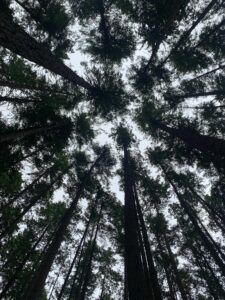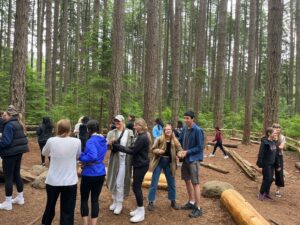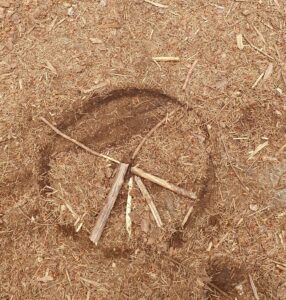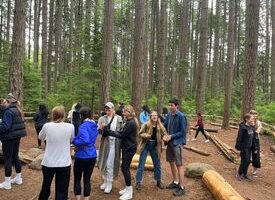
Pacific Spirit Regional Park, Chancellor Blvd, Vancouver, BC, Canada
On July 18th, we visited Pacific Spirit Park and together our group had the following reflections to this week’s guiding questions….
How can we connect students with nature on the lands?
Our field trip to Norma Rose Point outdoor education area presented many opportunities to learn and practice how we can connect students with nature on the land. The most prominent activity to connect students with nature at a primary level was the practice of using our senses. Several of the lessons we got to experience, including our own (Hug a Tree) were focused on the practice of using our senses to connect with nature. Another way we practiced connecting with nature was through stories. In another lesson, we practiced mapping through questions and learning from the land through wonder. This fits very nicely with our group’s inquiry question. Our trip to Norma Rose Point was a wonderful experience to practice outdoor learning!
What activities can students enjoy in nature?
Students can enjoy using their creativity to make stories about the nature around them. They can play guessing games with senses like we did in class today, or draw pictures of nature around them. Students can enjoy a simple walk through the forest. Games like tag or man hunt are also enjoyable to play in the forest. Bringing story workshop outside could be fun. Students can research and write about various plants around them and make a project about it. Students can make seesaws out of logs to explore equality and inequality. Students can look for math stories in nature. Students can also make art out of natural materials.
How can we lead collaboratively?
Spending time outside connecting to the land is a great opportunity to incorporate more student-led activities into your teaching, to take a step back as ‘leader’ of the class, so students can develop their own leadership abilities and take on more responsibility together.
It is important to provide students with the opportunity to explore their natural surroundings on their own or in small groups, but it can be extremely beneficial to then allow time for students to share their discoveries and stories, so they can learn from each other. Sharing ideas while sitting in a circle naturally promotes and encourages collaboration, and gives an equal voice to each child. It is critical for students to feel their contributions are valued and respected. It is also important for the teacher to join this circle, to show students they are all on a journey of learning together.
Outdoor learning activities are also an opportunity for students who might not feel as confident in traditional classroom math or language arts activities to shine. If there is a student who is knowledgeable about local flora and fauna, this is the perfect setting to invite them to share that knowledge with their peers – perhaps they would like to share some interesting facts about local creatures, or help peers identify local plants that provide a delicious outdoor snack, like huckleberry bushes!
Outdoor learning is the perfect opportunity to relinquish some of the control as leader of a class, and invite students to share their own stories, and engage in activities and content in ways that are meaningful to them – giving students the opportunity to shape their own learning means they are more invested in their own learning process.
How can we fully participate?
One of the ways that we can engage students to fully participate in activities is by providing a why to what we are doing. Today in our experience at Norma Rose, every group that presented a teachable activity provided a “why”. This “why” provides students with opportunities for meaning-making beyond what we are saying and can help provide perspective what we do in learning spaces (indoor or outdoor) and how it can relate to our well being, knowledge on others, and knowledge on the community and/or environment. Something that I think that was well done was also giving students choices. At times today, we were expected to close our eyes if we were comfortable to do so. I loved this because as teachers we understand that while this might be fun for some people, this could be a scarier/uncomfortable experience for others. On top of this, doing hands on activities, including humour, engaging in as many senses possible also makes high engagement which leads to full participation because students see others having fun and want to feel included and involved as well.
What can we learn from others?
Our class experience at Norma Rose highlights the numerous benefits of outdoor learning. Creating space for collaborative learning experiences beyond the classroom can help us to strengthen interpersonal relationships in the presence of nature. Today, we learned that there is lots to be learned by connecting with others through the art of storytelling. Storytelling is a vehicle for connection and knowledge that allows us to learn and grow. As our group experienced today, many of us were able to nurture our sense of wonder by learning to make inferences about the land. These inferences were a catalyst for rich discussions as many of us shared various testimonies and lived experiences that resonate with the principle of interconnectedness. While working in groups, some of us spoke to culturally significant practices or environmental stewardship, while others shared their plant knowledge and expertise. In so many ways, story is a medium that provides us with invaluable learning experiences as we continue to discover that learning is reciprocal, reflexive, experiential, and relational.
How does today’s experience connect with our inquiry question? (What stories does the land have to tell)
While at the Norma Rose outdoor classroom we connected with our inquiry question “what stories does the land have to tell?” At this spot, we learned on the land and with the land to collaboratively engage in outdoor education. Our learning took place on the traditional, ancestral and unneeded territory of the Musqueam peoples and this land was inhabited thousands of years prior to colonization. The traditional uses of this land tells a story within itself. The physical location of this spot cam also tell us many stories. The logs and rocks are strategically placed in a semi-circle with lends itself well to educational settings. The fenced off area directs the learning to be done within the confines of the barriers and protects surrounding plants and ecology around it. The plants and animals can also tell us a story. At this spot, we saw a diverse range of plants, insects, and animals that inhabit this land.

New perspectives

Hug a tree!

Creating mandalas from found natural materials

